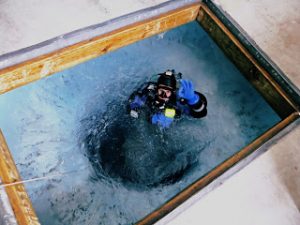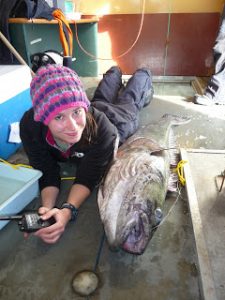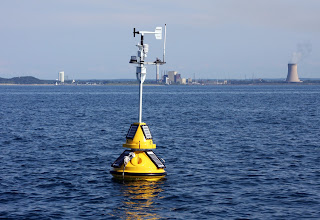February 18th, 2016 by IISG
With over 200 sessions spanning three days and an Exhibit Hall featuring leaders in the STEM industry, the Hoosier Association of Science Teachers, Inc. Conference is the premier professional development and networking opportunity for science teachers in Indiana. This year, science teacher Jed Freels shared lessons learned over his 34-year teaching career.
Jed was one of 15 teachers who worked alongside scientists on the U.S. EPA R/V Lake Guardian on the Lake Michigan Shipboard Science cruise this past summer. His enthusiasm and captivating style clearly represent his teaching goal: You should feel good about yourself and the job you’re doing.
“You are the scientist and the classroom is your lab,” he stated. “What do your students see when they walk in your class? Is there something new, different, and engaging that wasn’t there before? Does your room convey a sense of passion and enthusiasm about science?
“It’s essential to keep students on their toes. The challenge for teachers is to constantly keep them guessing about what to anticipate next. Your role is to encourage kids to become scientists—to do science, not just talk about it.”
Jed came with great examples of going the extra mile—volunteering at organizations to make connections and obtain educational resources; or finding a research project that you can be a part of as a volunteer. Once you’ve established a partnership, he explained, reach out and ask if the organization or researcher would be willing to provide your students with materials or a field-based experience.
He prompted teachers to be the gateway to our park systems. “Take an active photo of yourself at a local park and share the picture with your students to provide an opportunity for them to see you as a scientist.
“Think locally about your field-based experiences. Sometimes it is the smallest thing that will spark your student’s interest in you as a scientist.”
While on the Lake Guardian this past summer, Jed took the opportunity to record a video series, Science Quest, for the classroom and beyond.
–By Terri Hallesy, IISG education coordinator, pictured above with Jed Freels (and a skeleton).
February 10th, 2016 by IISG
The Illinois Water Resources Center (IWRC) and Illinois-Indiana Sea Grant (IISG) are pleased to be among the group of researchers and outreach professional to receive the 2016 Team Award for Excellence from the University of Illinois College of Agricultural, Consumer and Environmental Science. The award recognizes the team’s ongoing collaboration on the Illinois Nutrient Loss Reduction Strategy.
“We are proud to have facilitated the development of the most comprehensive and collaborative approach to nutrient loss reduction in the state’s history,” said Brian Miller, IWRC and IISG director and one of six staff members named in the award. “We look forward to working with the University of Illinois team, state agencies and other stakeholders to ensure strategy goals are met in the coming years.
Award winners also include University of Illinois Extension Director George Czapar as well as researchers from the departments of Natural Resources and Environmental Sciences and Agricultural and Consumer Economics who led a scientific assessment of current nutrient loads and cost-effective reduction strategies.
Released in 2015, Illinois’ strategy is a blueprint for improving water quality at home and in the Gulf of Mexico by reducing nitrogen and phosphorus losses from farm fields, city streets, and wastewater treatment plants. It’s suite of voluntary and mandatory practices are expected to ultimately cut nutrient loading to rivers and streams by 45 percent.
The plan was developed by a working group facilitated by IWRC and IISG for the Illinois Environmental Protection Agency (EPA) and Illinois Department of Agriculture. Group members included representatives from state agencies, agriculture, non-profit organizations and sanitation districts.
February 8th, 2016 by IISG
I have always been interested in fish biology, growing up and scuba diving in Massachusetts, but I became interested in fisheries policy through my graduate work at the University of Illinois at Urbana-Champaign.
My doctoral research focused on Antarctic fish physiology, specifically the blood antifreeze proteins that these fishes have in order to survive in the extreme cold temperatures of the Southern Ocean.
My dissertation research showed a link between environmental temperature and antifreeze protein activity and concentration in different, commonly caught fish species in the Antarctic. One of the largest Antarctic fish species which possesses antifreeze proteins is the Antarctic toothfish (also known as the Chilean seabass).
We caught just seven of these fish during my first field season, and I learned about the toothfish fishing industry and the international politics regarding Antarctic resource management which falls under the jurisdiction of the Commission for the Conservation of Antarctic Marine Living Resources (CCAMLR) . I wrote grants to study this little-understood fish while at the University of Illinois and tried to learn as much as I could about CCAMLR and the research that goes into making policy decisions.
. I wrote grants to study this little-understood fish while at the University of Illinois and tried to learn as much as I could about CCAMLR and the research that goes into making policy decisions.
I am very excited to be a 2016 Knauss Fellow in the National Marine Fisheries Service Office of International Affairs and Seafood Inspection. I was placed within this office after a grueling but rewarding week of presentations and interviews in Washington, DC. I traveled to DC with 53 other incredible finalists for placement with hosts in the federal government. We heard presentations from the 56 possible host offices on projects ranging from fisheries, satellites, climate change, habitat, and many more. Over the next two and a half days I interviewed with 15 different offices, the majority of which were within NOAA, and by Friday I selected placement in the Office of International Affairs and Seafood Inspection.
 Though I do not know specifically what I will be working on, some of the projects could include the US-Mexico and US-Canada bilateral trade agreements, work with the International Convention for the Conservation of Atlantic Tuna, work with CCAMLR, and fishery bycatch policy. I will have a year of intensive international fisheries policy training where I am sure to learn a lot.
Though I do not know specifically what I will be working on, some of the projects could include the US-Mexico and US-Canada bilateral trade agreements, work with the International Convention for the Conservation of Atlantic Tuna, work with CCAMLR, and fishery bycatch policy. I will have a year of intensive international fisheries policy training where I am sure to learn a lot.
Lauren Fields, University of Illinois’ 2016 Knauss Marine Policy Fellow, received her PhD from the Department of Animal Biology at the University of Illinois in May. She started on February 1, 2016 with NOAA in Maryland.
For more information about the Knauss fellowships and other opportunities, please visit the Fellowship and Scholarship page.
February 3rd, 2016 by IISG
Members of IISG’s aquatic invasive species team are introducing their newest risk assessment suite of products today at the Illinois and Wisconsin Landscape Show in Schaumburg, Illinois.
The brochure, wallet card, and poster distill all the complexities of the species assessments done by researchers at the University of Notre Dame, Loyola University Chicago, and the Nature Conservancy. IISG facilitated the meetings between the researchers and retailers to ensure that the tools developed for them to use to assess the risk for invasion met the states’ needs.
These assessments provide retailers and hobbyists with information about whether a plant or animal imported for the aquarium and water garden trades poses a threat to the states’ waterways.
Greg Hitzroth, IISG aquatic invasive species outreach specialist will be urging retailers at the conference to not sell or grow plant species that are known to be invasive.
“The retailers and wholesalers—the types of folks who are at this trade show—want to do the right thing,” Hitzroth said. “And we’re here to help them.”
You can download the materials for free from these links! If you need a specific quantity, contact Danielle Hilbrich, aquatic invasive species outreach specialist, at hilbrich@illinois.edu.
What’s in Your Water Garden – Wallet Card
What’s in Your Water Garden – Brochure
What’s in Your Water Garden – Poster
January 22nd, 2014 by IISG
The cure for some of the world’s deadliest diseases may be living at the bottom of the Great Lakes. This is the theory Brian Murphy, a medicinal chemist at the University of Illinois at Chicago (UIC), set out to test in 2012 when he scoured Lake Huron in search of a largely unexplored type of bacteria that may hold the key to new treatments.
The IISG-funded study unearthed more than 600 strains of freshwater actinomycete bacteria, making it one of the largest “libraries” of its kind in the world. Murphy—with help from UIC researchers Scott Franzblau, Joanna Burdette, and Lijun Rong—is still testing whether these strains can be used to create new treatments for tuberculosis and other life-threatening diseases. But their initial results suggest that at least a handful of freshwater bacteria could lead to new cures.
A microbe’s medicinal power lies in the small compounds they make to defend themselves, which can destroy cell walls, prevent DNA from replicating like it should, and more. Current treatments for many diseases are built around the chemical defenses used by land-based cousins of the bacteria Murphy has collected. But some treatments, like the ones for tuberculosis, require patients to be on a complex cocktail of antibiotics for months at a time. Worse still, a growing number of diseases are now resistant to standard drugs. The hope is that some of the freshwater bacteria in Murphy’s library might create molecules that dangerous pathogens have yet to evolve defenses against.
“Researchers have been operating on the assumption that bacteria in the lake are nearly identical to what are found on the land,” said Murphy. “But we think these freshwater strains are likely to produce new molecules that target diseases in different ways.”
Murphy and his team will spend the next few months scrutinizing chemical compounds from 10 actinomycete strains already showing disease-fighting potential and comparing them against known antibiotics, anti-virals, and anti-cancer agents. At the same time, they will keep working through their bacterial library hoping to find even more molecules with drug-like potency.
Just as important as finding new molecules is learning more about the relationship between a microbe’s chemical properties and where it lives. This is where Murphy’s library of strains really comes in. Its size and diversity will help reveal both whether aquatic actinomycete bacteria are significantly different than their land-based counterparts and if strains found in different lakes use unique chemical defenses.
“One of the biggest barriers in the discovery of new drugs is knowing where to look,” said Murphy. “Knowing where bacteria populations are similar and where they are different helps us figure out exactly where to sample when looking for new drugs.”
Because of his collection, Murphy has already discovered that the makeup of actinomycete communities in Lake Huron varies both by location and depth, a diversity that makes the lake a potentially important site in the hunt for new cures.
September 17th, 2012 by IISG
IISG staff members and interns traveled to the Indiana shoreline earlier this week to help launch an environmental sensing buoy four miles off the coast of Michigan City, Indiana. They were joined by researchers from the Purdue University School of Civil Engineering, who partnered with IISG to develop the buoy, and staff at the Indiana DNR.
School of Civil Engineering, who partnered with IISG to develop the buoy, and staff at the Indiana DNR.
IISG Science Writer Anjanette Riley was there for the launch and recalls the day’s events:
“If I had to describe the launch process in one word, it would be ‘meticulous.’ The approximately 6-hour process was carefully divided into a series of steps: Steps for the final calibration of the real-time data sensors, steps for placing the 2,000 lb anchor on the lake bottom, steps for rigging the buoy up to be dragged behind the DNR boat to its final destination in 62-foot water, and still more steps for attaching it to the anchor’s line. To a passer-by the process must have looked a little hectic, with people running around securing lines and popping back-and-forth from the building to test light-sensitive sensors. And maybe things were a little chaotic at times, but a chaos complete with checklists.
This is not to say that the day played out without any hiccups. In fact, the whole thing almost had to be scrapped for another day because of a malfunctioning light needed to announce the buoy’s existence to nearby boaters. Cary Troy, the lead researcher on the project, had brought four of these lights from Purdue just in case one didn’t work. Four proved to be too few, though, when the time came to install it atop the buoy. We knew going in that the buoy might not be able to go out that day. There was always the chance that the weather would not be on our side that morning and we would need to wait for another, better day. But with the weather the best it had been for several days, the anchor sitting on a barge at the Port Authority ready to be carried out into the lake, and the buoy all working as planned, a small but important light stood in the way.

To keep the day moving, the team decided to divide and conquer. Cary Troy and graduate student Jun Choi rode the four miles out into the lake on a flat barge carrying the buoy’s anchor, hoping to at least get that in place on the scheduled day. A temporary buoy was attached to the anchor to mark the location and hold the line that secures to buoy in place until the real thing was ready.
Meanwhile, IISG’s Naoki Wada set about trying to repair the light. As a summer intern, Naoki was a key player in the buoy development and continued to lead the way during much of the launch. Step one in the repair process was to hook the light up to a car battery to charge. Once out on the lake, the light is designed to charge during the day using a series of solar panels and flash in 15-second intervals at night or when overcast. That afternoon, though, the sun was replaced with the faster-acting car battery. Step two involved making a series of alterations to the light to test why the now-charged light was not consistently functional. In the end, the launch date was saved when Naoki discovered that removing an internal screw was enough to keep the light working as designed.

With the light finally mounted in place, IISG and crew from the Indiana DNR set about rigging the buoy to safely lower it into the water. The weight and the sensitivity of its sensors meant that the crew needed to be in constant control of the buoy’s movement from the minute it entered the water—something much easier said than done with a machine designed to float. The rigging and lowering process was perhaps the most meticulous part of the day, with as many as eight people at one point tying rope, connecting chains, checking the balance of weight, supporting the buoy into the water, and preventing it from floating under the boat as it drove away from the dock.

The same ropes and chains were then used to transport the buoy four miles into the lake at about 5mph, the manufacturer-recommended speed for dragging a buoy behind a boat. The last step was to remove the drag lines and attach the buoy to the anchor line put in place earlier that day in a process that looked much like the rigging of an hour earlier acted out in reverse. Months of work planning, developing, and launching the buoy were capped off by the whole launch crew snapping photos of the now-operational buoy as the DNR boat sped back to shore.”
To read more about how the buoy will support research into the weather patterns and biology of Lake Michigan and help beachgoers plan visits to Indiana’s shores, visit IISG’s news page.
Special thanks to Naoki Wada for his extensive work ensuring the buoy was operational in time for last week’s launch and overseeing the day’s events. Additional thanks to Brian Breidert, Randy Brindza, Ben Rhoda, and Jamie McNeill IV from Indiana DNR.





